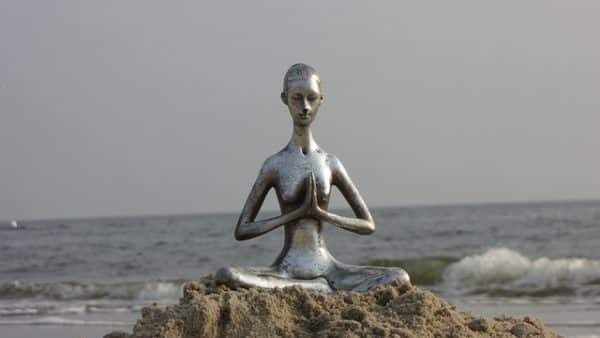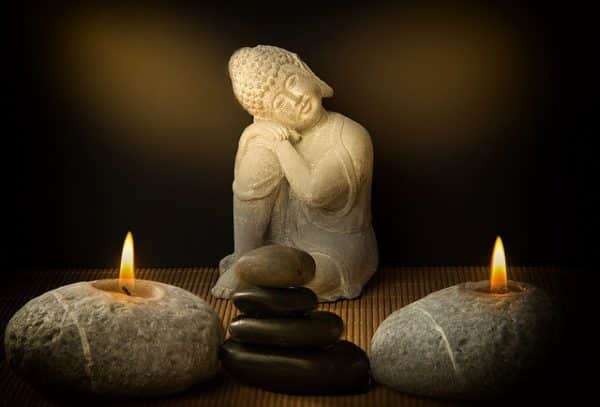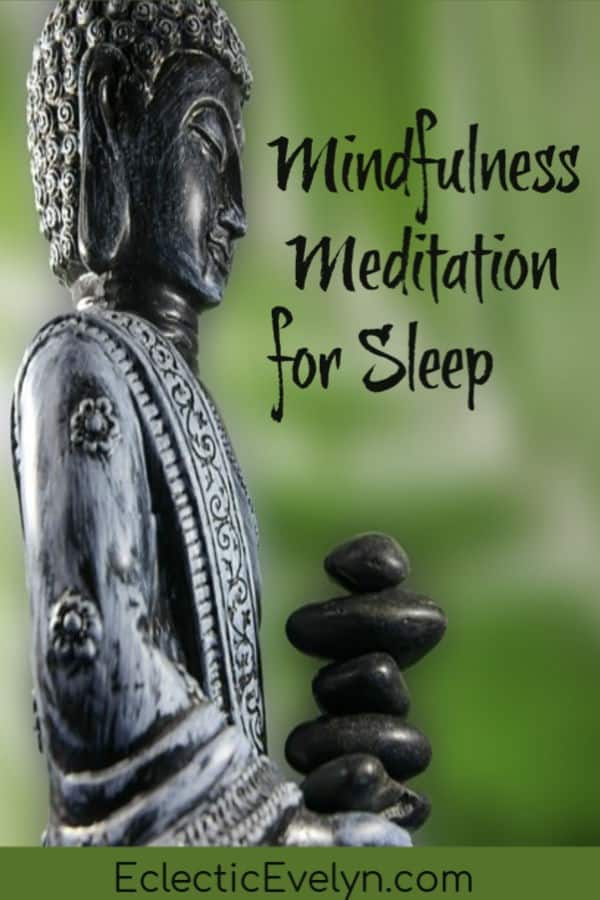Sleep has eluded me many times when I have a lot on my mind. One night of restless sleep turns into weeks due to insomnia, and that made it very hard to focus on my day to day life. Work suffered, relationships suffered, and even my home life suffered as a result of battling insomnia.
Then I learned about mindfulness and how it can help to improve my sleep. I was skeptical at first, but now I am a firm believer in the practice of mindfulness and meditation to help improve sleep when my mind is running amok.
Let me tell you how mindfulness and meditation can help you achieve the good nights rest you are desperately needing.

Benefits of Mindfulness Meditation
Mindfulness Meditation can help you achieve a better night’s sleep and reduce insomnia occurrences. Dr. Herbert Benson, Director Emeritus of the Harvard-affiliated Benson-Henry Institute for Mind-Body Medicine has concluded through studies that mindfulness meditation works.
Dr. Benson has concluded that practicing mindfulness meditation for a minimum of 20 minutes will help give you the relaxation you need to sleep.
Through the practice of mindfulness meditation, you will learn to invoke the sense of relaxation when it comes time to get some shut-eye. The relaxation response that is induced through mindfulness meditation should be made sitting up or moving around while doing yoga when you practice during the day because it will make you sleepy when you need to be awake.
Dr. Benson recommends a two-step process for Meditation.
Step 1: Choose a calming focus. Some of the better calming focuses are your breath, positive words that you recite (such as “peace” or “relaxing”), a phrase that has meaning (such as “breath away from the tension” or “I am calm and relaxed”), a short prayer or even just a sound. You can repeat whatever you choose to focus on either silently or out loud as you inhale or exhale.
Step 2: Let go and relax. You don’t want to worry about how you are doing. You want to keep your mind focused, so when it wanders bring it back to the moment and take deep breaths. You want to gently return your attention to what you choose to focus on that brings you into a state of relaxation.
What is Meditation for Sleep?
Meditation helps to train us to get out of our heads and focus more on the present moment. You tend to get lost in thoughts that can interrupt your sleep. However, when you stop and focus on the moment by being still, we can focus on the present moment better.
Meditation for sleep is much more specific. What it does is help guide you away from the day and focus more on resting the mind while at the same time resting your body.
Scientifically, meditation for sleep will help to lower your heart rate by lighting up your parasympathetic nervous system while encouraging slower breathing. The result is increasing the prospect of getting a quality night’s sleep.
Mindfulness for Sleep
When you are stressed and focused on what happened during the day plus what is going to happen tomorrow, you can’t sleep. Practicing mindfulness, along with meditation before bed, is a tool that you can use to shut the “noise” in your head off. Mindfulness helps you to focus more on the present, and thus you will worry less when falling asleep.

10 Steps to Mindfulness
Through these steps to mindfulness, you will quickly realize that you will fall asleep faster. However, don’t worry or stress if you find your mind wandering a lot as you begin. It takes time and repeated practice to be able to achieve mindfulness without your mind running away on you.
- While laying comfortably in your bed, take five deep breaths. You will breathe in through your nose and out through your mouth. While you breathe focus on the air going into your lungs. While you breathe out, focus on the day’s events disappearing.
- Check-in on how you’re feeling both in mind and body. Your mind may be full of various thoughts; you want to try to avoid whisking those thoughts away, just let them do their thing. Take your time with this part.
- Divert your awareness to the physical point of contact. Focus your attention on how your body feels against the mattress. Feel yourself sinking in the bed and focus on where your body dips into the bed the strongest. Those spots are the point of contact. Is your weight evenly balanced? Notice sounds around you and focuses on them.
- At this point, try to focus on how your body feels. When you begin, first focus on whether your body feels heavy or light. Try to get an accurate picture by mentally scanning your body. If you find you are focusing on the parts of your body that are tense, that is alright. As you do that the tension will release.
- Bring your attention to your breathing and body movements associated with breathing. Focus on your breath. Are you breathing shallow? Long? Short? Smooth?
- If you notice your mind wandering during Step 5, that is alright as it means you are in the present. Gently bring your mind back to your breathing.
- Gently move into this phase by allowing yourself to think back to the very first part of the day you remember. How did you feel upon waking up? Then go through each moment of the day in your mind. Remember that this is just an overview and should only take a couple of minutes. If you find that your thoughts have wandered and stayed at a specific moment in the day, gently return your focus to the overview.
- Having brought yourself back to the present moment, you can go back to focusing on how your body feels. Focus on the small toe of your left foot and imagine you are shutting off for the night.
- Do the same for the next toe and the next. Continue your way up to your body and stop at the waist. Focus on the feeling of “switching off” your joints, muscles, and so forth. Do this for both legs.
- Continue this exercise up through the rest of your body. Take a moment to enjoy the feeling of releasing the tension. Now you can allow your mind to wander where it wants to go and quickly you will find that you are falling asleep.
Breathing Exercises for Sleep
When you mingle Meditation Mindfulness and breathing exercises, you will find that it will be difficult at first. However, it will become more useful the more you practice.
Breathing Exercise One:
How to do to your breathing exercises:
- Allow your lips to part a little bit and make a slight whooshing sound as you exhale through your mouth.
- Close your lips and silently allow yourself to inhale through your nose while counting to four in your head.
- Hold your breath for seven seconds.
- Exhale again with the whooshing sound for eight seconds.
- Try to avoid being too alert at the end of each cycle — practice mindfulness.
- Complete this cycle for four breaths. Let your body embrace sleep as you feel the relaxation.
Breathing Exercise Two:
Another great breathing exercise is when you close your eyes and take notice of your breathing. Turn all your attention to your natural breathing rhythms. Feel as the air enters and leaves your nose or your mouth. Visualize the air passing through from your mouth. Then to your airways and down to your diaphragm and back out again.
Check your body mentally for tension and as you exhale, feel that tension going out with the air. Visualize your breath as though it can reach your forehead, shoulders, neck, and arms. Release the tension as you exhale. If you are mind wanders, gently bring it back to your breathing

Guided Imagery for Sleep
The idea behind guided imagery is to allow you to focus your mind on a story or an image so that your mind can stop focusing on the things that keep you awake.
Lay down comfortably on your bed. Close your eyes and try to relax. To start, you want to visualize a scene, story, or memory that is calming to you. You can imagine a relaxing vacation or an activity that you find relaxing, like reading a book.
The idea is to find something other than your worries or stresses to focus on that will make you feel relaxed. You want it to be something that you would find relaxing. Create the scenario in your mind. Focus on all the details from colors to smells. Be mindful of the details and go through them slowly.
If you find your mind wandering, acknowledge what it is thinking about and redirect your attention back to the relaxing moment. You may find that it takes time to perfect guided imagery, and that’s alright. You will get better as you practice it.
Final Thoughts
Mindfulness meditation takes practice and time. Don’t worry if you find you have a hard time getting going. The last thing you want to do is stress over not being able to de-stress. It’s not easy to retrain your mind to let go of the worries and tensions of the day.
For me, it took lots of practice. Eventually, I was able to achieve a deep sleep faster as I got better at going through the steps to a successful mindfulness meditation practice. You will find that as you practice it daily, it will get more comfortable for you too.
It is never easy to achieve the desired results, and getting a restful sleep will take time. However, nothing worthwhile is ever easy to make. Soon, you too will find that you can get to sleep faster and have a more fulfilled sleep that will leave you feeling refreshed and ready to tackle the day ahead.

Author Bio:
Suja Johnkutty: Dedicated physician, mom, and visionary. If I could live in a Relaxation Retreat half the year, I would. From an overwhelmed state, I realized to embrace the solace that comes from meditation, mindfulness, and the love of comforts at home after a busy day. Let me share them with you in BetterRelaxation.com to amplify your self-care and enhance your vibrancy.






Great tips for rest and relaxation.
#trafficjamweekend
This sounds great. I should try it because I do get insomnia from time to time. Thanks for posting!